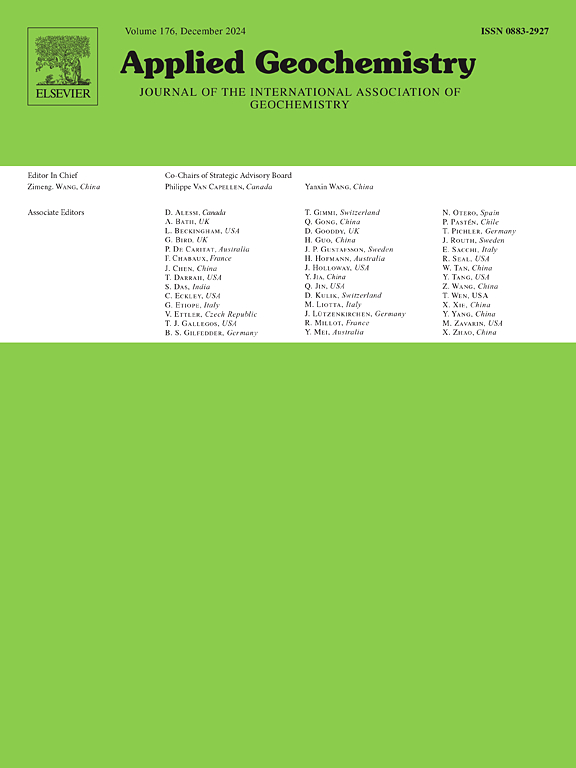岩浆-热液系统的机器学习应用:矿床的石英微量元素洞察
IF 3.4
3区 地球科学
Q1 GEOCHEMISTRY & GEOPHYSICS
引用次数: 0
摘要
岩浆-热液活动对成矿至关重要,因为它形成了各种具有经济意义的矿床。石英化学是确定此类矿床类型和成因的关键;然而,使用二元/三元石英微量元素图的传统分析方法不足以阐明石英化学的全部复杂性。为了解决这一限制,机器学习被应用于分析高维石英化学并提高识别精度。我们收集了8710份石英样品,这些样品来自不同的地质环境,包括各种寄主岩和矿床,它们来自I型、S型和a型岩浆,并检测了18种微量元素。我们开发了两种方法-极度贪婪树提升-递归特征消除- shapley加性解释(XGBoost-RFE-SHAP)和主成分分析-均匀流形逼近和投影(PCA-UMAP) -基于石英微量元素来区分这些地质环境。XGBoost-RFE-SHAP实现了高精度的石英微量元素鉴别。B、Ti、P、Li、Ge和Al是识别I型、S型和a型母岩浆的关键。对于与i型岩浆有关的岩石和矿床,关键的鉴别标志包括Ti、Ge、Al、Li、Sb和P;s型岩浆为Ge、P、Ti、Al、Li、B;a型岩浆有Ti、P、K、Al、Rb、As。PCA-UMAP生成了岩石和矿床分类图,揭示了不同地质环境下的石英微量元素模式。这种综合方法增强了对岩浆-热液演化的理解,并为识别经济上可行的矿床提供了强大的工具,在不同的地质环境中具有潜在的应用前景。本文章由计算机程序翻译,如有差异,请以英文原文为准。
Machine-learning applications for magmatic–hydrothermal systems: Quartz trace-element insights into ore deposits
Magmatic–hydrothermal activity is critical in ore genesis, as it forms a variety of economically significant ore deposits. Quartz chemistry is key to identifying the types and origins of such deposits; however, conventional analytical methods that use binary/ternary quartz trace-element plots are insufficient for elucidating the full complexity of quartz chemistry. To address this limitation, machine learning is applied to analyze high-dimensional quartz chemistry and improve the identification accuracy. We compiled 8710 quartz samples from a range of geological environments including various host rocks and ore deposits derived from I-, S-, and A-type magmas, and examined 18 trace elements. We developed two approaches—eXtremely Greedy tree Boosting-Recursive Feature Elimination-SHapley Additive exPlanations (XGBoost-RFE-SHAP), and Principal Component Analysis-Uniform Manifold Approximation and Projection (PCA-UMAP)—to discriminate these geological environments based on quartz trace elements. XGBoost-RFE-SHAP achieved highly accurate discrimination and identified key quartz trace elements. B, Ti, P, Li, Ge and Al are key to identifying I-, S-, and A-type parental magmas. For rocks and ore deposits related to I-type magma, key discriminators include Ti, Ge, Al, Li, Sb, and P; for S-type magma, Ge, P, Ti, Al, Li, and B; and for A-type magma, Ti, P, K, Al, Rb, and As. PCA-UMAP generated plots for classifying rocks and ore deposits, revealing quartz trace-element patterns across various geological environments. This integrated approach enhances the understanding of magmatic–hydrothermal evolution and offers a powerful tool for identifying economically viable deposits, with potential applications in diverse geological settings.
求助全文
通过发布文献求助,成功后即可免费获取论文全文。
去求助
来源期刊

Applied Geochemistry
地学-地球化学与地球物理
CiteScore
6.10
自引率
8.80%
发文量
272
审稿时长
65 days
期刊介绍:
Applied Geochemistry is an international journal devoted to publication of original research papers, rapid research communications and selected review papers in geochemistry and urban geochemistry which have some practical application to an aspect of human endeavour, such as the preservation of the environment, health, waste disposal and the search for resources. Papers on applications of inorganic, organic and isotope geochemistry and geochemical processes are therefore welcome provided they meet the main criterion. Spatial and temporal monitoring case studies are only of interest to our international readership if they present new ideas of broad application.
Topics covered include: (1) Environmental geochemistry (including natural and anthropogenic aspects, and protection and remediation strategies); (2) Hydrogeochemistry (surface and groundwater); (3) Medical (urban) geochemistry; (4) The search for energy resources (in particular unconventional oil and gas or emerging metal resources); (5) Energy exploitation (in particular geothermal energy and CCS); (6) Upgrading of energy and mineral resources where there is a direct geochemical application; and (7) Waste disposal, including nuclear waste disposal.
 求助内容:
求助内容: 应助结果提醒方式:
应助结果提醒方式:


